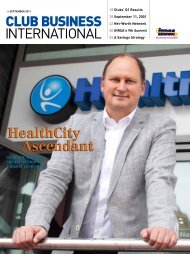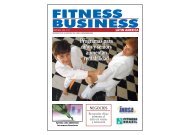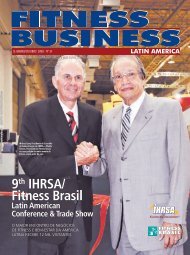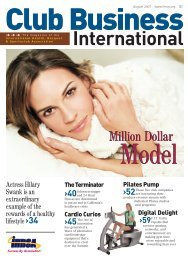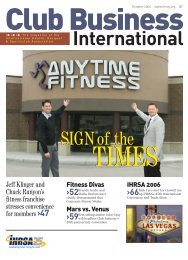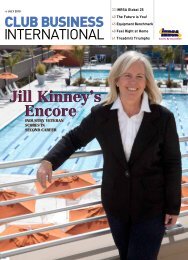Augie In Action! Augie In Action! - Ihrsa
Augie In Action! Augie In Action! - Ihrsa
Augie In Action! Augie In Action! - Ihrsa
You also want an ePaper? Increase the reach of your titles
YUMPU automatically turns print PDFs into web optimized ePapers that Google loves.
Tracy Powell<br />
| Last Rep |<br />
Clubs Fill Exercise<br />
Prescriptions<br />
“Physical inactivity is a fast-growing public health problem in this<br />
country and contributes to a variety of chronic diseases and health<br />
conditions.” So reads a release announcing a new initiative,<br />
“Exercise is Medicine,” from the American Medical Association (AMA).<br />
T<br />
hose of us in the health and fitness club industry<br />
have long accepted, as a given, that exercise provides<br />
wonderful health benefits. Now, nearly every day,<br />
research confirms the soundness of our conviction.<br />
The medical community is proving that the services<br />
we’ve been offering for years are a powerful, costefficient<br />
tool in both disease prevention and treatment.<br />
Recently, the obesity pandemic<br />
has focused attention on<br />
one of the health ramifications<br />
of inactivity, but, as the AMA<br />
notes, it also contributes to a<br />
wide range of other chronic<br />
diseases and medical complications,<br />
including cancer,<br />
diabetes, high blood pressure,<br />
coronary artery disease, anxiety<br />
and depression, arthritis<br />
and osteoporosis.<br />
As the health implications<br />
have become clear, the resulting<br />
economic problems have<br />
become obvious. Lifestylerelated<br />
conditions have the<br />
potential to destroy healthcare systems, wreak<br />
havoc with economies, and even, potentially,<br />
bankrupt governments.<br />
Corporations, insurers, healthcare providers,<br />
public officials—all have been forced to admit that<br />
regular exercise, especially when conducted in the<br />
safe and supportive environment that clubs provide,<br />
is a critical part of the solution.<br />
For years, industry leaders—Lloyd Gainsboro, of<br />
the Dedham Health and Fitness Complex, and Phil<br />
Wendel, of the ACAC Fitness and Wellness<br />
Center, prominent among them—have pushed for<br />
“exercise prescriptions,” i.e., a recommendation, by<br />
doctors, that their patients become more active.<br />
Their idea was formally endorsed last fall when the<br />
AMA and American College of Sports Medicine<br />
(ACSM) launched “Exercise is Medicine.”<br />
Joe Moore<br />
IHRSA President & CEO<br />
224 Club Business <strong>In</strong>ternational | MARCH 2008 | www.ihrsa.org<br />
IHRSA is proud to be an official supporter of<br />
this program.<br />
“If we had a pill that contained all of the<br />
benefits of exercise, it would be the most widely<br />
prescribed drug in the world,” observes Ronald M.<br />
Davis, M.D., the president of the AMA and a keynote<br />
speaker, this month, at IHRSA’s 27th Annual<br />
<strong>In</strong>ternational Convention and Trade Show in San<br />
Diego. Davis will discuss “Improving the Health of<br />
the Nation Through Policy, Lifestyle, and Treatment,”<br />
at 11 a.m. on March 7, in conjunction with the Art<br />
and Science of Health Promotion Conference.<br />
The AMA and ACSM have set a number of<br />
important goals for “Exercise is Medicine.” They’re<br />
hopeful that the program will:<br />
1. Create a broad awareness that exercise is, in fact,<br />
a form of medicine.<br />
2. Make “level of physical activity” a standard vitalsign<br />
question raised during every patient visit.<br />
3. Help physicians and other healthcare providers<br />
become consistent and effective in counseling<br />
and referring patients with respect to their<br />
exercise needs.<br />
4. Promote policy changes, in both the private<br />
and public sectors, to support physical-activity<br />
counseling and referrals in clinical settings.<br />
5. Produce an expectation, among patients and the<br />
public at large, that healthcare providers should and<br />
will ask about, and prescribe, exercise.<br />
6. Encourage physicians and other healthcare<br />
providers to be physically active themselves.<br />
The medical community has acknowledged the<br />
problem and identified a remedy. Now, we must<br />
reach out to healthcare providers, providing them<br />
with the information they need to assure them that,<br />
when they’re in our clubs, their patients are in<br />
excellent hands. —|<br />
– Joe Moore, jmoore@ihrsa.org<br />
.org<br />
For full details about the AMA/ACSM program, log on to<br />
www.exerciseismedicine.org.<br />
One Hundred Twenty Million<br />
Members by 2010



